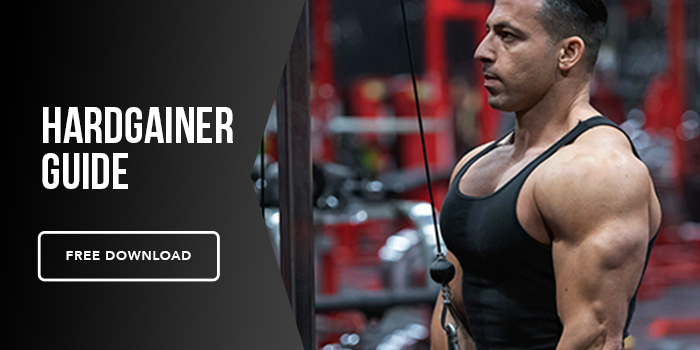Frequency - 2-3x/week
More isn’t better. We want to give your body the max signal it needs to grow and that’s it. As a beginner, you're so sensitive to the stimulus of lifting that 2-3 days a week will more than send a strong signal to grow. It’s also at a frequency that as that signal comes down (48-72 hours) you send a fresh stimulus again to bring it back up.
Exercises - Compound Exercises (Squat, Deadlift, Overhead Press, Bench Press)
These movements are what you want to prioritize because they use more muscles to accomplish the movement and allow you to work up to really heavy weight. An isolation exercise on the other hand, tends to only focus on one muscle, and the weights don’t usually allow you much room for growth compared to a compound. This allows you to get more bang for your buck within a session (great if lifting isn’t your passion), and focus on movements that will grow your physique the quickest.
Sets & Reps - 8-10 sets, per week, per muscle
A beginner lifter only needs 8-10 sets per muscle per week to get the effective dose. Doing more work doesn’t mean more gains. You need just enough to maximize the muscle building signal. Again, extra sets are only needed when that minimum dose no longer results in growth. Think of it adding in more sets only as needed to break through sticking points (like a long plateau on an exercise). The rep range can vary each phase of training, so that you can stimulate all fibers of a muscle (more on that later).
The Workout
This is just a sample workout. There are many ways you can construct this, and if you want a full workout plan I suggest checking out the MAPS Anabolic program. It’s the perfect workout for beginners.
Frequency: 2-3x a week (keep 1-2 days of rest in between to recover)
Length: 4 week cycle with one week deload
Sets & Reps: 2-5 sets with 3-6 reps per exercise (rest up to 3 minutes between sets)
Exercises:
Day 1 -
Barbell Squats 4x6-10
Bench Press 4x6-10
Weight/Assisted Pull-ups 3x6-10
Shrugs 3x3-10-15
Barbell Curls 2x6-10
EZ Bar Skullcrushers 2x6-10
Day 2 -
Deadlifts 4x6-10
Overhead Press 4x6-10
Seated Row 3x6-10
Dumbbell Shrugs 3x10-15
Dumbbell Hammer Curls 2x6-10
Dips 2x6-10
Day 3 (only if you aren’t sore and are recovering from Day 2)-
Romanian Deadlifts 4x6-10
Lunges 4x6-10
Incline Bench 4x6-10
One Arm Dumbbell Row 3x6-10
Lateral Raises 3x6-10
Preacher Curls 2x6-10
Tricep Pushdowns 2x6-10
Phasing
As mentioned earlier, phasing your rep ranges allows you to stimulate all fiber types of a given muscle. For example some fast twitch muscle fibers respond better to lower rep, high load work. Others, like slow twitch muscle fibers, respond better to higher rep, moderate weight where the muscle needs to be kept under constant tension. You will never FULLY maximize your physique unless you are focusing on all aspects of a muscle and its fibers.
Focus on a rep range of 6-10 (like above) for 4-6 weeks and then deload. Then the next 4-6 weeks maybe you’ll try similar exercises in the 10-12 rep range and deload again. Also, make sure to be choosing a weight that allows you to hit whatever rep range you choose leaving 2-3 reps shy of when your form would start to break down.
Deload
As you keep increasing in weights and/or reps, over a 4-6 week training block you may notice it gets harder and harder to keep improving. This is a sign your body is accumulating fatigue and hitting a maximum recoverable volume. It’s telling you it’s time for a deload where you will train at less volume to let your body recover and catch back up.
The deload week is when you do half as many sets, and half as many reps but with the same weight you used on your final week. This is how growth accumulates over the long haul. If we just kept pushing it and ignored our body’s signals, we might actually risk LOSING muscle, or gaining half as much as we should.
It’s a Process
The biggest takeaway you need to have is that this is a journey. You putting on size takes time. They say a novice lifter can put on 10-20lbs of muscle in this first year. Every year after that it goes down. By the time you’re 4+ years into lifting you are looking at MAYBE 5 pounds of muscle in an entire YEAR. Any program you choose you must follow for at least 6-12 weeks to let your body respond to the stimulus being placed. Just make sure as mentioned above you are changing the rep ranges every 4-6 weeks to allow for the muscle to respond to SLIGHTLY new stimulus. If you do change the exercises, make sure they are a similar movement to the ones listed (for example, switch out a back squat for a front squat, not a leg extension).






